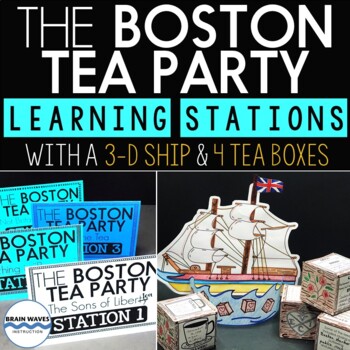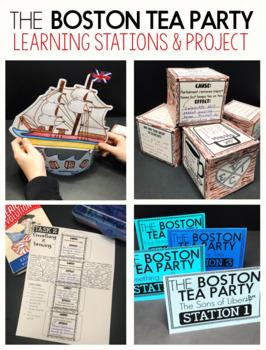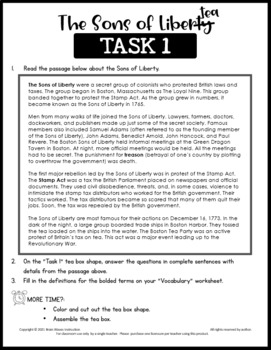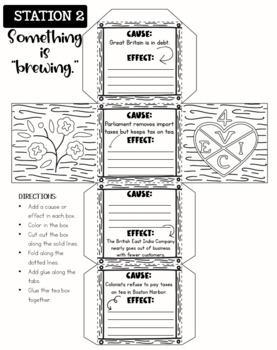The Boston Tea Party Reading Passage Learning Stations and Project
- PDF
What educators are saying
Description
This resource contains four detailed learning stations with tasks designed to help students learn about the Boston Tea Party. Each station includes reading passages about critical elements of the event. Students will build background and knowledge as they learn about the moments before, during, and after the Boston Tea Party.
Check this out! As students learn about the Boston Tea Party, they will complete their work on tea box shapes. When they have finished each task, they will turn their learning into a set of four 3-dimensional tea boxes. Students will add vocabulary to a ship shape. Then, they will assemble a 3-D version of the ship, The Beaver. The ship will be an interactive showcase of their learning. Your students will love these engaging activities and their 3-D display of their learning!
Designed to be versatile, the engaging tasks work as learning stations, but they can be easily adapted for whole- group instruction or even independent studies. Just choose the instructional style that works best for your setting and students.
ABOUT THE LEARNING STATIONS:
The learning stations are designed to help students learn about the Sons of Liberty, the events leading up to the Boston Tea Party, the night of the Tea Party, and the aftermath of the Boston Tea Party.
STATION 1: The Sons of Liberty
Students read a passage about the Sons of Liberty. Then, they will answer short answer questions on the tea box shape.
STATION 2: Something is “Brewing”
Students gain insight into the events leading up to the Boston Tea Party. They will note causes and effects on the tea box shape.
STATION 3: Spill the Tea
Students learn details about the night the Boston Tea Party occurred. Then, they will note the 5 W’s of the event on their tea box shape.
STATION 4: Not Britain’s Cup of Tea
Students will read a passage about the aftermath of the Boston Tea Party. They will report their insights on their tea box shape.
ALL STATIONS: Vocabulary
Students will be exposed to important vocabulary at each station. They will collect the definitions for 8 words associated with the Boston Tea Party.
ABOUT THE 3-D TEA BOXES and SHIP
Students will easily create a 3-D Boston Tea Party scene complete with a replica of The Beaver and four 3-D tea boxes. They'll cut out their work and combine it to make the 3-D model! It's easy to create, but the "wow factor" can't be beat!
INCLUDED IN THIS DETAILED RESOURCE:
This resource is absolutely turn-key! Everything you need is included!
- Station Implementation Guide
- Station Grade Tracker
- Station Vocabulary Worksheet
- Station Table Labels (4)
- Teacher Resources - Detailed Station Overview and Set-Up Guides (5)
- Station Materials (reading passages, directions, tea box cube worksheets)
- Step-by-Step guide for make the tea boxes and ship
- Keys (for all station activities)
You may also like:
- Geography Doodle Vocabulary – 50 Words!
- Homework Twist Task Cards (use with any assignment)
- Growth Mindset Doodle and Do Activities (use all year long!)
- Classroom Community and Kindness Activities (build a connected classroom community)
Following is fun!
Get the inside scoop on all store discounts, free products, and product launches. Just click the green “Follow Me” star under my store name on this page or click the green “Follow Me” star on my store homepage.
Let’s Stay in Touch!
*** Click HERE to receive the Brain Waves Instruction Newsletter filled with exclusive FREEBIES and Teaching Tips!
Thanks!
Brain Waves Instruction





